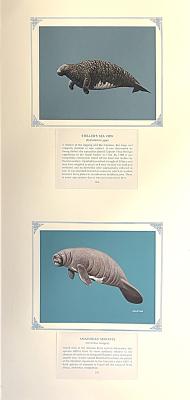PAINTINGS - (a) FIN WHALE & (b)BLUE WHALE
c. 19752 paintings in single framed work (a) Fin Whale - 2 dark grey long, streamlined whales, with lighter under-belly, V-shaped heads and prominent dorsal fins, the bottom whale with white right lower jaw (48) (b) Blue Whale-long, slender bodied, mottled blue-gray (49); gouache on blue card, framed and mounted with inscription
Collection of 106 of paintings by Richard Ellis that were selected by the Smithsonian Institution to form a traveling exhibit of the marine mammals of the world. The collection was purchased by Perth businessman Kevin Parry in 1985 and donated to Whale World, now known as Albany's Historic Whaling Station.
Details
Details
FIN WHALE (Balaenoptera physalus)
The second largest of the great whales, the fin whale reaches a maximum length of about 80 feet, and may weigh 60 tons. It is probably the fastest of the great whales and has been called the "greyhound of the seas." The fin whale is the only consistently asymmetrically colored mammal in the world: all fin whales are white on the right side of the lower jaw and black on the left. The reasons for this unusual asymmetry are unknown, but they may have something to do with the animal's feeding habits. An opportunistic feeder, the fin eats small fishes as well as krill (small shrimp-like creatures). Fin whales used to be hunted in the Antarctic, but their numbers were so depleted that they are now protected throughout most of their range.
48.
BLUE WHALE (Balaenoptera musculus)
The blue whale is generally considered the largest and heaviest animal that has ever lived. Females-which grow larger than males, as with most baleen whales-have been measured at over 100 feet and weigh more than 150 tons. Blue whales are born at a length of about 24 feet, and at a weight of 2-3 tons. After weaning, the blue whale feeds almost exclusively on small shrimp-like crustaceans known as euphausiids, and may require as many as 40 million per day. Although not as rare as many people think (there may be as many as 10,000 left in the world), blue whales are fully protected throughout the world's oceans.
49.
Smithsonian label checklist # 48,49 Packing case # 2, AWHS accession number
The paintings represent a body of work by well-known American marine conservationist, author, artist and natural historian Richard Ellis (1938-2024).
Copyright and Reference
Copyright and Reference
Albany's Historic Whaling Station
Albany's Historic Whaling Station
Other items by Richard Ellis
- PAINTING - COMMON DOPLHIN
- PAINTING - FINLESS PORPOISE
- PAINTING - (a) INDO-PACIFIC HUMPBACK DOLPHIN & (b) ROUGH-TOOTHED DOLPHIN
- PAINTINGS - (a) RIGHT WHALE & (b) BOWHEAD WHALE
- PAINTINGS - (a)Longfin Pilot Whale (b)Shortfin Pilot Whale
- PAINTINGS OF (a)BELUGA & (b)NARWHAL
- PAINTING - STRAP-TOOTHED WHALE
- PAINTING - (a) Steller's Sea Cow (b) Amazonian Manatee
- PAINTING - CARIBEAN MANATEE
- PAINTINGS - (a) DUSKY DOLPHIN & (b) PEALE'S DOLPHIN
- PAINTINGS - (a) WEST AFRICAN HUMPBACK DOLPHIN & (b) TUCUXI
- PAINTINGS - (a) HARBOR PORPOISE (b) VAQUITA
More items like this
Other items from Albany's Historic Whaling Station
- PAINTING - SPERM WHALE
- PAINTING - PYGMY RIGHT WHALE
- PAINTING - KILLER WHALE
- PAINTING - HECTOR'S BEAKED WHALE
- PAINTING - ARCH BEAKED WHALE
- PAINTING - COMMERSON'S DOLPHIN
- PAINTING - DUGONG
- PAINTING - POLAR BEAR
- PAINTING - SEA OTTER
- PAINTING - RISSO'S DOLPHIN
- PAINTING - HEAVISIDE'S DOLPHIN
- PAINTING - FALSE KILLER WHALE

